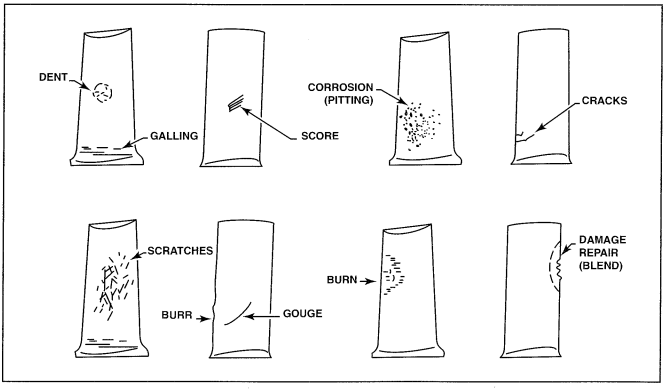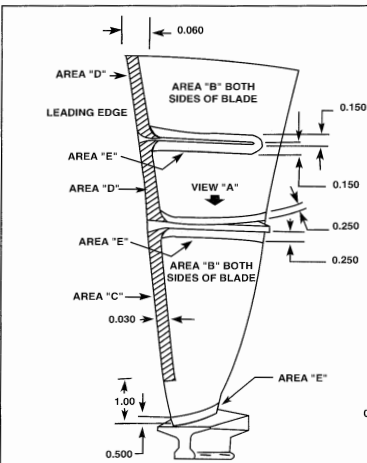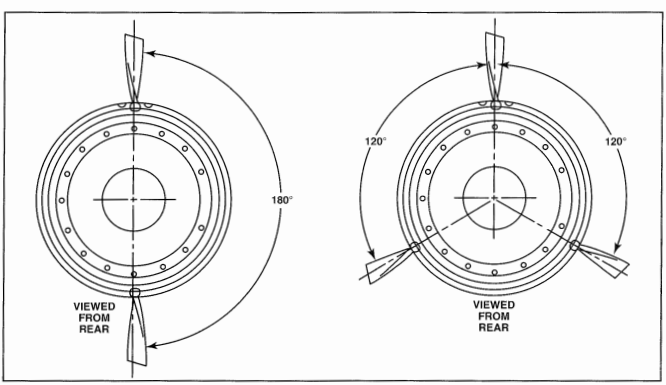Turbine Engine Overhaul (Jeppesen Powerplant 4-B)
0.0(0)
0.0(0)
Card Sorting
1/32
Earn XP
Description and Tags
4-18 through 4-40, only the overhaul portions and terms related to overhaul.
Study Analytics
Name | Mastery | Learn | Test | Matching | Spaced |
|---|
No study sessions yet.
33 Terms
1
New cards
Who can overhaul a turbine engine?
* The Manufacturer
* An approved overhaul facility (Repair station)
* An approved overhaul facility (Repair station)
2
New cards
What are the general steps in an engine overhaul?
1. Disassembly
2. Cleaning
3. Inspection
4. Remove & Replace
5. Reassembly
6. Testing
3
New cards
INSPECTION TERMS
__**Blending**__
__**Blending**__
A method of filing compressor or turbine blades and vanes to remove damage and reestablishing the appropriate contour for an aerodynamic shape.
4
New cards
INSPECTION TERMS
__**Blistering**__
__**Blistering**__
Raised areas that indicate a separation of a surface layer from a base metal. Blistering is often evident as peeling (or flaking) of a metal plating.
5
New cards
INSPECTION TERMS
__**Bow**__
__**Bow**__
A stress-induced bend or curve in a blade's contour.
6
New cards
INSPECTION TERMS
__**Bulge**__
__**Bulge**__
An outward bending or swelling caused by excessive pressure or weakening due to excessive heat.
7
New cards
INSPECTION TERMS
__**Compression**__
__**Compression**__
A squeezing force produced by two opposing forces acting on a part.
8
New cards
INSPECTION TERMS
__**Creep**__
__**Creep**__
A condition of permanent elongation in rotating airfoils resulting from thermal stress and centrifugal loading. Creep is also referred to as growth.
9
New cards
INSPECTION TERMS
__**Dynamic Balancing**__
__**Dynamic Balancing**__
A procedure used to balance the main rotating assembly of a turbine engine along both its rotational plane and the rotor axis.
10
New cards
INSPECTION TERMS
__**Electrolytic Action**__
__**Electrolytic Action**__
Breakdown of surfaces caused by electrical activity between dissimilar metals. Electrolytic action is also known as galvanic corrosion.
11
New cards
INSPECTION TERMS
__**Flowing**__
__**Flowing**__
The spreading out of a plated or painted surface caused by poor adhesion to the base or excessive loading on the part's surface
12
New cards
INSPECTION TERMS
__**Galling**__
__**Galling**__
The fretting ( or chafing) of a mating surface by sliding contact with another surface or body.

13
New cards
INSPECTION TERMS
__**Glazing**__
__**Glazing**__
The development of a hard, glossy surface on bearing surfaces in the presence of oil, heat, and pressure.
14
New cards
INSPECTION TERMS
__**Growth**__
__**Growth**__
A term synonymous with creep.
15
New cards
INSPECTION TERMS
__**Guttering**__
__**Guttering**__
Deep concentrated erosion that results from an enlargement of cracks or repeated exposure to a concentrated flame.
16
New cards
INSPECTION TERMS
__**Profile**__
__**Profile**__
The contour or aerodynamic shape of a blade or surface.
17
New cards
INSPECTION TERMS
__**Shear**__
__**Shear**__
A tearing force produced by two opposing, parallel forces acting on a part.
18
New cards
INSPECTION TERMS
Static Balancing
Static Balancing
A procedure that balances the main rotating assembly of a turbine engine to reduce vibration
19
New cards
INSPECTION TERMS
Tension
Tension
A force that tends to pull an object apart.
20
New cards
INSPECTION TERMS
Untwist
Untwist
A straightening and loss of blade curvature that results from gas loads, thermal stress, and centrifugal loading.
21
New cards
What is a blisk?
A turbine wheel that incorporates the blades and disk in one piece
22
New cards
What is the purpose of blending a compressor or turbine blade?
* Reduce concentrated stresses at sharp points in the blade
* reduce the possibility of the crack or defect spreading
* reduce the possibility of the crack or defect spreading
23
New cards
Common defects found in the combustion section of a turbine engine
* Cracks
* Burner-can shift
* Hot spots or scorched areas
* Warpage
* Erosion
* Excess weld material over welded repair seams
* Burner-can shift
* Hot spots or scorched areas
* Warpage
* Erosion
* Excess weld material over welded repair seams
24
New cards
Hottest part of a turbine engine?
The first set of turbine nozzle vanes
This makes them susceptible to the most cracking and stress
This makes them susceptible to the most cracking and stress
25
New cards
You should replace a cracked component whenever cracks appear to be ________
Converging
26
New cards
What is Primary Creep?
Creep related to an engines first run
27
New cards
What is Secondary Creep?
Creep that happens slowly over many hours of operation
28
New cards
What is Tertiary Creep?
Creep related to hot starts, overtemp events, and extended high power operation
\
**This is the one that is dangerous and warrants Turbine Over Temperature (TOT) inspections.**
\
**This is the one that is dangerous and warrants Turbine Over Temperature (TOT) inspections.**
29
New cards
As a general rule, where on a turbine or compressor blade is NO damage allowed?
Near the blades base or, if shrouded, where the blade meets the shroud

30
New cards
What are the typical options when repairing a combustion liner?
* Weld (or reweld) cracks
* Replace liner
* Replace liner
31
New cards
Why is balancing critical for rotating assemblies on a turbine engine?
High rotational speeds can cause severe vibration if parts are unbalanced
32
New cards
When replacing turbine or compressor blades, what is the general procedure?
If the blades are marked with their weight, you can install just one, given the weights of the other blades are approximately the same. you may have to install more than one new blade if the engine blades have been worn over time. This is done to ensure proper balancing.
\
On wheels that have an even number of blades, 2 blades can be installed 180 degrees apart
On wheels that have an odd number of blades, 3 blades can be installed 120 degrees apart
\
On wheels that have an even number of blades, 2 blades can be installed 180 degrees apart
On wheels that have an odd number of blades, 3 blades can be installed 120 degrees apart

33
New cards